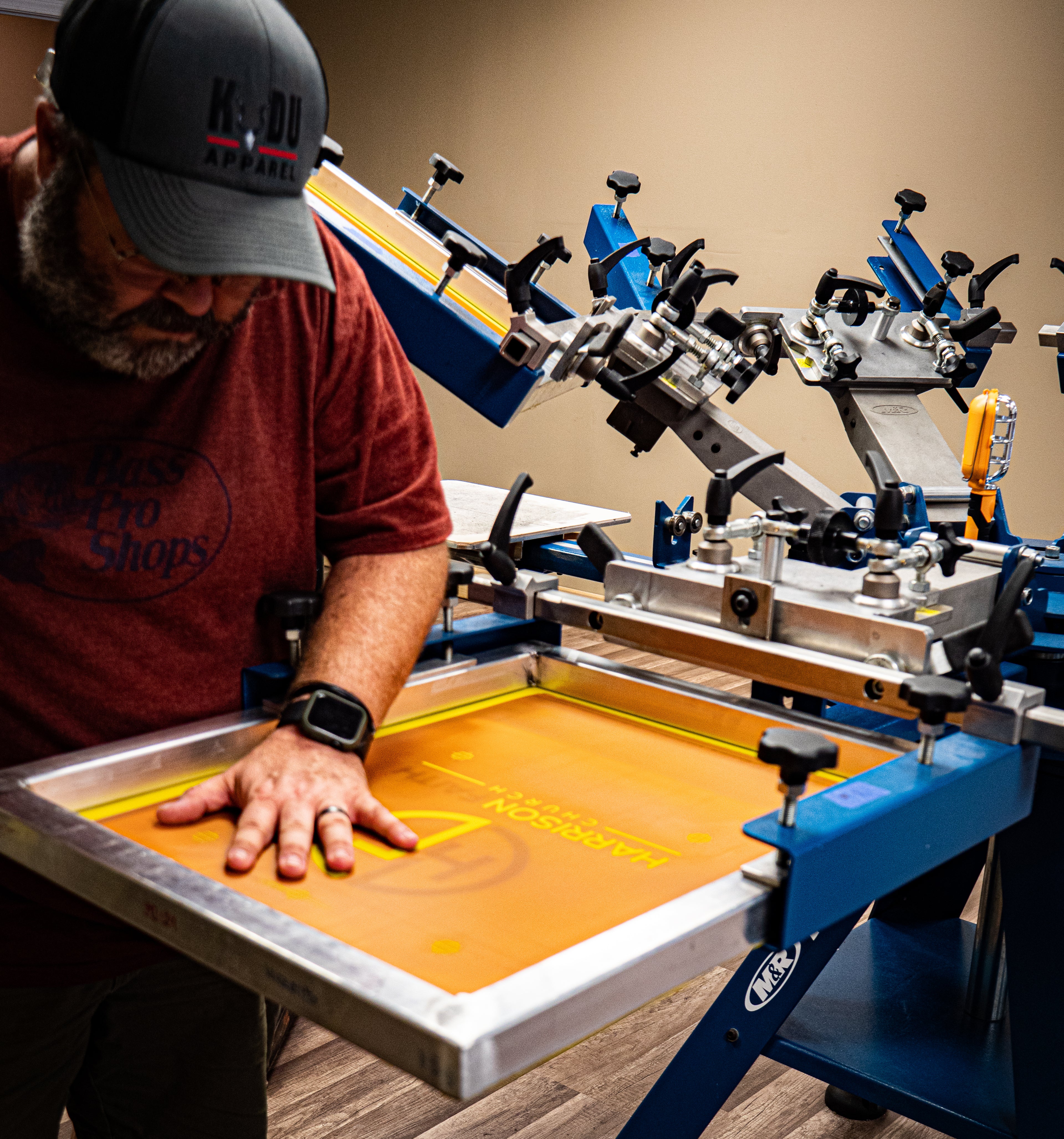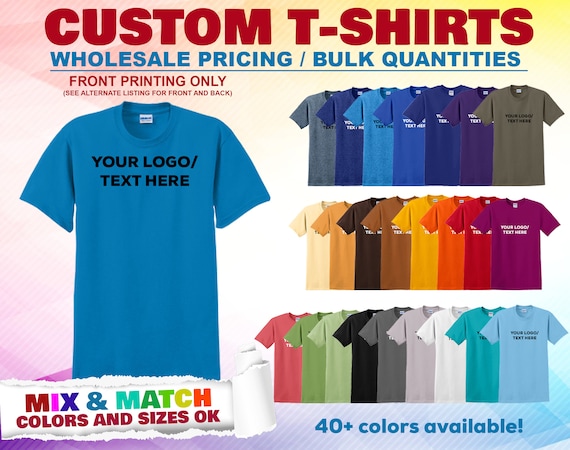The Ultimate Display Printing Package: Crucial Devices for Effective Garment Printing
When it concerns screen printing, having the right devices can make all the distinction. Your package must include fundamentals like a tough framework, a reliable squeegee, and a top quality direct exposure system. Yet what about the screens and inks? Choosing the best products tailored to your specific jobs is vital. You'll quickly discover how these components function with each other to raise your printing game. Let's explore what each device offers the table and exactly how to maximize their possibility.
Understanding Screen Printing Basics
When you involve yourself in display printing, you'll find it's both an art and a science. When dried out, you expose the screen to UV light with your style placed on top, permitting you to develop a stencil.
Next, you'll establish up your printing station, aligning your display with the garment. Using a squeegee, you'll push the ink through the display, making certain also protection. The elegance of display printing exists in its versatility; whether you're printing bold graphics or complex patterns, the procedure continues to be the very same.
As you practice, you'll find out about ink types, drying out times, and shade blending. Each print is an opportunity to improve your method and express your imagination, making display printing a fulfilling endeavor for anybody passionate about layout.
Necessary Elements of the Display Printing Package
To begin with display printing, you need to comprehend the essential components of your kit. You'll wish to acquaint yourself with the basic tools, the kinds of inks and solutions you'll use, and the tools for application. Each aspect plays an important role in accomplishing premium prints on your garments.
Basic Devices Introduction
A fully equipped display printing kit is important for any individual looking to produce stunning garment styles. Beginning with a tough display printing structure, which holds your mesh securely for exact printing. With these important parts, you'll have a solid structure for your display printing journey and can focus on bringing your creative visions to life.
Inks and Solutions
After collecting the standard devices, your next emphasis must get on emulsions and inks, which play an essential role in achieving resilient and vibrant prints. When selecting inks, consider water-based, plastisol, or discharge inks based on the fabric type and preferred finish. Water-based inks are soft and environmentally friendly on garments, while plastisol offers durability and intense shades.
Emulsions, on the various other hand, are essential for producing your displays. You'll want to select a high-grade emulsion that fits your ink type and direct exposure technique.
Devices for Application

Picking the Right Screens for Your Projects
When you're selecting screens for your jobs, the mesh count and structure product are essential variables to consider. A greater mesh count is terrific for great information, while the right frame material can improve longevity and security. Comprehending these components will assist you accomplish the finest lead to your display printing endeavors.
Display Mesh Matter
Selecting the ideal display mesh count is necessary to attaining the desired outcomes in your screen printing jobs. The mesh matter refers to the number of strings per inch in the display, impacting how much ink obtains moved onto your garment. Constantly take into consideration the kind of ink and textile you're using, as these elements influence the mesh matter selection.
Mount Material Options
The screen structure product you choose plays a significant function in the top quality of your prints. They provide superb stress, guaranteeing crisp prints. Ultimately, select a material that matches your operations and budget while guaranteeing your prints come out looking expert and sharp.
Choosing Inks for Various Fabrics
Exactly how do you ensure your screen printing layouts look last and lively on different materials? Selecting the appropriate ink is essential. For cotton, water-based inks are your best choice. They saturate into the textile, giving a soft feel and superb sturdiness. If you're printing on polyester or artificial blends, take into consideration using plastisol inks. They rest on top of the material, assuring intense shades and great bond.
Don't ignore specialty inks like discharge or metallic inks. Discharge inks can remove dye from fabric, leaving a soft print, while metal inks add a shiny surface that attracts attention. Constantly test your inks on the certain fabric before devoting to a huge run; this helps you assess color vibrancy and resilience.
Lastly, bear in mind the textile's weight and appearance. Selecting the ideal ink for every material type will ensure that your styles not only look wonderful yet also withstand the test of time.
The Significance of Squeegees in Printing
Squeegees play an essential function in accomplishing high-quality prints in screen printing. They're your primary tool for moving ink via the pattern custom screen printing onto the textile, and the appropriate squeegee can make all the distinction. When you apply consistent pressure with a squeegee, you ensure an even distribution of ink, minimizing the opportunities of irregular or blotchy prints.
Picking the ideal durometer or firmness of your squeegee is important, as it affects just how much ink is drawn with the mesh. A softer squeegee is terrific for comprehensive designs, while a stronger one functions well for strong graphics. Additionally, the size of the squeegee must match your screen dimension to enhance your printing process.
Taking time to understand your method with the squeegee will result in cleaner, sharper prints. So, don't undervalue this important tool-- be familiar with it, and you'll elevate your display printing video game.
Preparing Your Artwork and Solution
Achieving great prints begins long prior to you choose up your squeegee. Initially, confirm your art work is high-resolution and formatted properly. Use vector graphics for crisp lines and scalability. When you more than happy with the style, print it on openness film, maintaining in mind that the darker the image, the far better it blocks light during exposure.
Apply it uniformly to your screen in a dimly lit area to stop early direct exposure. Once your screen is prepared, subject it to UV light according to your solution's guidelines (custom screen printing).
After cleaning out the unexposed solution, allow the display dry fully. With your artwork and emulsion prepared, you're set for the printing procedure!
Upkeep Tips for Resilient Devices
Although it could appear laborious, normal upkeep of your screen printing tools can significantly extend their lifespan and warranty regular outcomes. Begin by cleaning your displays quickly after usage.
For mops, wipe the blade after each usage to stop ink from drying on it. On a regular basis inspect for nicks or damage and replace them as required. Do not neglect your exposure system-- clean the glass surface frequently to verify suitable light direct exposure.

Regularly Asked Questions
Can I Screen Publish on Dark Colored Fabrics?
Yes, you can evaluate print on dark colored fabrics! Just utilize a suitable nontransparent ink designed for dark materials.
Exactly how Do I Clean My Displays After Publishing?
To cleanse your displays after printing, you'll require a stress washing machine or tube to get rid of excess ink. Then, make use of a screen cleaner or mild detergent with a soft brush to scrub away residue. Rinse completely.
What Security Gear Do I Need While Screen Printing?
When display printing, you'll require handwear covers to protect your hands, a mask to avoid breathing in fumes, and safety goggles to shield your eyes from inks and chemicals. Bewaring warranties a risk-free and pleasurable experience.
Can I Utilize the Kit for Other Products Besides Fabric?
Yes, you can use the kit for various other products besides textile. It works well on surfaces like paper, plastic, and wood. Just make certain the ink and techniques match the product you select.
Exactly how Long Does It Consider Ink to Treat?
Ink usually takes about 24 hours to heal totally, but it can vary based upon the type and density. You'll wish to examine the producer's standards for specific treating times to ensure perfect outcomes.
Using a squeegee, you'll push the ink with the screen, ensuring even protection. You'll require a reliable squeegee, which aids evenly disperse ink across your display.Selecting the right display mesh count is crucial to accomplishing the desired results in your display printing jobs. The mesh matter refers to the number of threads per inch in the display, affecting just how much ink gets moved onto your garment.To clean your screens after printing, you'll require a pressure washing machine or hose pipe to get rid of excess ink.